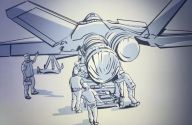I remember reading that there was a discussion or something like that among the designers of the J-20 or J-XX (?). They were discussing the choice between canards or LERX and one said 'why not both?'
Do you or anyone else for that matter have a link to the paper of S. Wencong? I want to know more about the canards+LERX combination now that the MIUS is basically a mini J-20. I would really appreciate it

I don't recall the paper going into that level of detail. Those sorts of things are rarely exposed and if so, are often either part of disinfo campaigns (probably not in this particular case) or lacking in depth of detail.
We can however exercise some common sense and assume the designers applied a canards + LERX configuration of that exact form (for J-20) because it was at the time the most ideal solution available as a net compromise of every other engineering problem for the program. This would mean it is specific to the J-20's exact geometries, dimensions, materials, weight distributions, CoG, and everything else of some mechanical nature that has an impact or is a consequence of other non-aerodynamic design choices e.g. weapons, sensors, electronics etc.
How that translates to MIUS' aerodynamic performance would be yet another step in conjecture since we can safely assume the internals and every mechanical aspect of J-20 and MIUS would be extremely difference despite sharing a general similarity in geometry/configuration. That is to say, the MIUS designers wouldn't have "copied" from J-20, they would have considered those exact canard + LERX configuration to be coincidentally suitable for the purposes of the MIUS and all its corresponding engineering problems and solutions.
I'm not an aeronautical engineer but having seen some of those SAC papers that generally touched upon the mods and improvements to FC-31 to J-35, it does seem even millimeters worth of change
can be significant enough in difference to the eventual performance of the aircraft.
What is commonly accepted is that canards vastly improve on the delta wing. Maybe LERX helps with some aspects in certain cases to make it worthwhile. We can then apply common sense to conclude that those cases coincide with both the J-20 and MIUS in uncertain domains (because we aren't the experts) but sure enough in such a way that their (expert) designers applied them.


